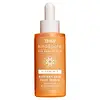What's inside
What's inside
 Key Ingredients
Key Ingredients

 Benefits
Benefits

 Concerns
Concerns

 Ingredients Side-by-side
Ingredients Side-by-side

Water
Skin ConditioningPropylene Glycol
HumectantGlycerin
HumectantSodium Ascorbyl Phosphate
AntioxidantPolysorbate 60
EmulsifyingDimethicone
EmollientPhenoxyethanol
PreservativeAcrylates/C10-30 Alkyl Acrylate Crosspolymer
Emulsion StabilisingXanthan Gum
EmulsifyingCaprylyl Glycol
Emollient1-Methylhydantoin-2-Imide
Skin ConditioningPolyacrylamide
Disodium EDTA
C13-14 Isoparaffin
EmollientSodium Hydroxide
BufferingParfum
MaskingLimonene
PerfumingEuterpe Oleracea Fruit Extract
Carica Papaya Fruit Extract
Skin ConditioningLaureth-7
EmulsifyingCitric Acid
BufferingLinalool
PerfumingPotassium Sorbate
PreservativeSodium Benzoate
MaskingHexyl Cinnamal
PerfumingCitral
PerfumingWater, Propylene Glycol, Glycerin, Sodium Ascorbyl Phosphate, Polysorbate 60, Dimethicone, Phenoxyethanol, Acrylates/C10-30 Alkyl Acrylate Crosspolymer, Xanthan Gum, Caprylyl Glycol, 1-Methylhydantoin-2-Imide, Polyacrylamide, Disodium EDTA, C13-14 Isoparaffin, Sodium Hydroxide, Parfum, Limonene, Euterpe Oleracea Fruit Extract, Carica Papaya Fruit Extract, Laureth-7, Citric Acid, Linalool, Potassium Sorbate, Sodium Benzoate, Hexyl Cinnamal, Citral
Water
Skin ConditioningGlyceryl Stearate
EmollientButylene Glycol
HumectantErythritol
HumectantFructooligosaccharides
HumectantAvena Sativa Kernel Extract
AbrasiveCeramide NP
Skin ConditioningCeramide Ns
Skin ConditioningCeramide Ng
Skin ConditioningCeramide As
Skin ConditioningCeramide EOP
Skin ConditioningCeramide AP
Skin ConditioningTocopherol
AntioxidantSodium Hyaluronate
HumectantGlycerin
HumectantC14-22 Alcohols
Emulsion StabilisingPEG-100 Stearate
Sodium Polyacryloyldimethyl Taurate
Emulsion StabilisingCaprylyl Methicone
Skin ConditioningSodium Benzoate
MaskingC12-20 Alkyl Glucoside
EmulsifyingC30-45 Alkyl Cetearyl Dimethicone Crosspolymer
EmollientIsohexadecane
EmollientPEG-7 Glyceryl Cocoate
EmulsifyingPhenoxyethanol
Preservative1,2-Hexanediol
Skin ConditioningHydrogenated Lecithin
EmulsifyingPropylene Glycol
HumectantCastor Oil Hydrogenated Ethoxylated
PerfumingEthylhexylglycerin
Skin ConditioningWater, Glyceryl Stearate, Butylene Glycol, Erythritol, Fructooligosaccharides, Avena Sativa Kernel Extract, Ceramide NP, Ceramide Ns, Ceramide Ng, Ceramide As, Ceramide EOP, Ceramide AP, Tocopherol, Sodium Hyaluronate, Glycerin, C14-22 Alcohols, PEG-100 Stearate, Sodium Polyacryloyldimethyl Taurate, Caprylyl Methicone, Sodium Benzoate, C12-20 Alkyl Glucoside, C30-45 Alkyl Cetearyl Dimethicone Crosspolymer, Isohexadecane, PEG-7 Glyceryl Cocoate, Phenoxyethanol, 1,2-Hexanediol, Hydrogenated Lecithin, Propylene Glycol, Castor Oil Hydrogenated Ethoxylated, Ethylhexylglycerin
Ingredients Explained
These ingredients are found in both products.
Ingredients higher up in an ingredient list are typically present in a larger amount.
Glycerin is already naturally found in your skin. It helps moisturize and protect your skin.
A study from 2016 found glycerin to be more effective as a humectant than AHAs and hyaluronic acid.
As a humectant, it helps the skin stay hydrated by pulling moisture to your skin. The low molecular weight of glycerin allows it to pull moisture into the deeper layers of your skin.
Hydrated skin improves your skin barrier; Your skin barrier helps protect against irritants and bacteria.
Glycerin has also been found to have antimicrobial and antiviral properties. Due to these properties, glycerin is often used in wound and burn treatments.
In cosmetics, glycerin is usually derived from plants such as soybean or palm. However, it can also be sourced from animals, such as tallow or animal fat.
This ingredient is organic, colorless, odorless, and non-toxic.
Glycerin is the name for this ingredient in American English. British English uses Glycerol/Glycerine.
Learn more about GlycerinPhenoxyethanol is a preservative that has germicide, antimicrobial, and aromatic properties. Studies show that phenoxyethanol can prevent microbial growth. By itself, it has a scent that is similar to that of a rose.
It's often used in formulations along with Caprylyl Glycol to preserve the shelf life of products.
Propylene Glycol is an odorless, colorless liquid. As a humectant, it helps skin retain moisture. It also aids in delivering active ingredients.
Another role of this ingredient is preventing a product from melting or freezing. Propylene glycol also adds antimicrobrial properties to a product, elongating product lifespan.
This ingredient is considered an organic alcohol and commonly added into both cosmetics and foods.
Those with sensitive skin or conditions may develop a rash when using this ingredient.
Learn more about Propylene GlycolSodium Benzoate is a preservative. It's used in both cosmetic and food products to inhibit the growth of mold and bacteria. It is typically produced synthetically.
Both the US FDA and EU Health Committee have approved the use of sodium benzoate. In the US, levels of 0.1% (of the total product) are allowed.
Sodium benzoate works as a preservative by inhibiting the growth of bacteria inside of cells. It prevents the cell from fermenting a type of sugar using an enzyme called phosphofructokinase.
It is the salt of benzoic acid. Foods containing sodium benzoate include soda, salad dressings, condiments, fruit juices, wines, and snack foods.
Studies for using ascorbic acid and sodium benzoate in cosmetics are lacking, especially in skincare routines with multiple steps.
We always recommend speaking with a professional, such as a dermatologist, if you have any concerns.
Learn more about Sodium BenzoateWater. It's the most common cosmetic ingredient of all. You'll usually see it at the top of ingredient lists, meaning that it makes up the largest part of the product.
So why is it so popular? Water most often acts as a solvent - this means that it helps dissolve other ingredients into the formulation.
You'll also recognize water as that liquid we all need to stay alive. If you see this, drink a glass of water. Stay hydrated!
Learn more about Water